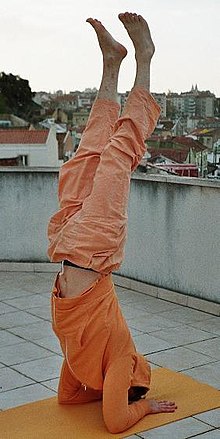Hatha yoga
Hatha Yoga ( Sanskrit , m., हठ योग, Yogi Hari , from hatha "strength, tenacity, oppression") is a form of yoga in which the balance between body and mind is achieved primarily through physical exercises ( asanas ), through breathing exercises ( Pranayama ) and meditation is sought. Hatha yoga originated at the beginning of the 2nd millennium BC. BC within Shivaitic Tantrism . An important later representative is Goraksha - a student of Matsyendra - who was also connected to Shivaitic tantrism. Svatmarama is considered to be the author of the Hathapradipika, a script from the 14th century, it ushered in the heyday of Hatha yoga in the 14th and 15th centuries. The later Gherandasamhita written by Gheranda , a Vishnu worshiper from Bengal , opens Hatha Yoga to a wider circle than Tantrism.
General
Tradition calls Kapila , author of the lost Samkhya Sutra , as the founder of the system, Samkhya ( Sanskrit , n., सांख्य, Sāṃkhya ; also Sāṅkhya). Whether this is a historical or a purely legendary person is controversial in research. The most important text source is the oldest surviving work in the tradition, the Samkhya-Karika of Ishvarakrishna , a collection of 72 teaching stanzas written between 350 and 450. The teaching in its present form is known from this text. The core time of Samkhya is the classical epoch (around 400 BC to around 700). The Mahabharata , the great Indian epic (300 BC-500) was clearly influenced by the Samkhya. The Samkhya had a close connection with yoga early on . The Samkhya provided the theory, the yoga formed the practice.
Hatha means violence or strength; this is to emphasize the effort that is necessary to achieve the ultimate goal. The term is also interpreted as an expression of the unity of opposing energies (hot and cold, male and female, positive and negative, sun and moon). The syllable “Ha” stands for sun (power, heating), the syllable “tha” stands for moon (silence, cooling).
The term Hatha Yoga was used in the Hathapradipika , a yoga script from the 15th century AD. There it distinguishes spiritual yoga (such as Raja Yoga ) from physical yoga (Hatha Yoga). Hatha Yoga refers to a stage on the way to Raja Yoga.
In addition to the Hathapradipika, there are two other important basic works of Hatha Yoga, the Gherandasamhita and the Shivasamhita . This makes it clear that even within Hatha Yoga there are differences of opinion on both theoretical and practical issues.
Hatha Yoga was initially designed to support other forms of yoga, but quickly enjoyed great popularity and was soon viewed as a separate form of yoga. In western culture, yoga is often mainly understood as hatha yoga.
Cleaning exercises
There are six main purification exercises, the Shatkriyas , which are an integral part of Hatha Yoga. They should systematically cleanse the body and its various cavities (throat, stomach, etc.) and free them from mucus. These practices, together with the asanas, are an important prerequisite for practicing pranayama and mudras .
literature
- Mikel Burley: Hatha Yoga. Lotos, Munich 2005, ISBN 3-7787-8171-5 .
- BKS Iyengar : Light on Yoga. Barth, Bern 2003, ISBN 3-502-63334-7 .
- Swami Satyananda Saraswati: Asana Pranayama Mudra Bandha. Bihar School of Yoga, Ananda, Cologne 2001, ISBN 3-928831-17-8 .
- Wilfried Huchzermeyer : The yoga dictionary. Sanskrit terms, exercise styles, biographies. edition sawitri, Karlsruhe 2006, ISBN 3-931172-25-2 .
- Swami Swatmarama: Hatha Yoga Pradipika. The lamp of Hatha Yoga. Phenomenon, Neuenkirchen 2007, ISBN 978-3-933321-61-9 .
- Lucy Lidell: YOGA - Sivananda Yoga Center. Mangalam Books, Lautersheim 2003, ISBN 3-922477-40-2 .
- Alexander Kobs: Shatkarma - The Secrets of Yoga Purification. Windpferd, Aitrang 2005, ISBN 978-3-89385-477-6 .
- Dietrich Ebert: Physiological aspects of yoga. Thieme, Leipzig 1986, ISBN 3-7404-0002-1 .
- Swami Sivananda Radha: Hatha Yoga: The Hidden Language, Secrects and Metaphors. Timeless Books, Kootenay Bay 2006, ISBN 1-932018-13-1 .
- Elisabeth Haich, Selvarajan Yesudian: Sport and Yoga. Aquamarine, Munich 2012 ISBN 978-3-89427-599-0 .
Web links
- Hatha Yoga Pradipika (Sanskrit and English) (PDF file; 451 kB)
References and comments
- ↑ Eckard Wolz-Gottwald: Yoga-Philosophy-Atlas. Experience of primordial awareness. Via Nova, Fuld 2006, ISBN 978-3-936486-04-9 , p. 137
- ↑ Shvetashvatara-Upanishad, VI, 13th century
- ↑ Werner Scholz: Hinduism. A crash course. Dumont, Cologne 2008, ISBN 978-3-8321-9070-5 , p. 68 f.
